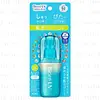What's inside
What's inside
 Key Ingredients
Key Ingredients

 Benefits
Benefits

 Concerns
Concerns

 Ingredients Side-by-side
Ingredients Side-by-side

Alcohol Denat.
AntimicrobialEthylhexyl Methoxycinnamate
UV AbsorberDimethicone
EmollientIsononyl Isononanoate
EmollientC12-15 Alkyl Benzoate
AntimicrobialDiethylamino Hydroxybenzoyl Hexyl Benzoate
UV FilterEthylhexyl Triazone
UV AbsorberPolysilicone-15
UV FilterTrimethylsiloxysilicate
EmollientAcrylates/Diacetoneacrylamide Copolymer
Dibutyl Ethylhexanoyl Glutamide
Skin ConditioningPolysilicone-9
Bis-Ethylhexyloxyphenol Methoxyphenyl Triazine
Skin ConditioningSqualane
EmollientBHT
AntioxidantParfum
MaskingAlcohol Denat., Ethylhexyl Methoxycinnamate, Dimethicone, Isononyl Isononanoate, C12-15 Alkyl Benzoate, Diethylamino Hydroxybenzoyl Hexyl Benzoate, Ethylhexyl Triazone, Polysilicone-15, Trimethylsiloxysilicate, Acrylates/Diacetoneacrylamide Copolymer, Dibutyl Ethylhexanoyl Glutamide, Polysilicone-9, Bis-Ethylhexyloxyphenol Methoxyphenyl Triazine, Squalane, BHT, Parfum
Water
Skin ConditioningEthylhexyl Methoxycinnamate
UV AbsorberPEG-30 Hydrogenated Castor Oil
EmulsifyingButylene Glycol
HumectantEthoxydiglycol
HumectantGlycerin
HumectantButyl Methoxydibenzoylmethane
UV AbsorberPhenylbenzimidazole Sulfonic Acid
UV AbsorberBis-Ethylhexyloxyphenol Methoxyphenyl Triazine
Skin ConditioningSucrose Stearate
EmollientIsostearoyl Hydrolyzed Collagen
CleansingSodium Hyaluronate
HumectantOak Root Extract
Skin ConditioningUlmus Davidiana Root Extract
Skin ConditioningLarix Kaempferi Root Bark Extract
Skin ConditioningWine Extract
AntioxidantRosa Canina Fruit Extract
AstringentStearyl Glycyrrhetinate
Skin ConditioningTocopherol
AntioxidantAloe Ferox Leaf Extract
Skin ConditioningRosmarinus Officinalis Leaf Oil
MaskingRose Flower Oil
MaskingLavandula Angustifolia Oil
MaskingCitrus Aurantium Dulcis Peel Oil
MaskingTetrahexyldecyl Ascorbate
AntioxidantIsostearic Acid
CleansingSucrose Dilaurate
EmollientHexyl Dimethylolpropionate
Sodium Hydroxide
BufferingC12-20 Alkyl Glucoside
EmulsifyingAlcohol
AntimicrobialParfum
MaskingWater, Ethylhexyl Methoxycinnamate, PEG-30 Hydrogenated Castor Oil, Butylene Glycol, Ethoxydiglycol, Glycerin, Butyl Methoxydibenzoylmethane, Phenylbenzimidazole Sulfonic Acid, Bis-Ethylhexyloxyphenol Methoxyphenyl Triazine, Sucrose Stearate, Isostearoyl Hydrolyzed Collagen, Sodium Hyaluronate, Oak Root Extract, Ulmus Davidiana Root Extract, Larix Kaempferi Root Bark Extract, Wine Extract, Rosa Canina Fruit Extract, Stearyl Glycyrrhetinate, Tocopherol, Aloe Ferox Leaf Extract, Rosmarinus Officinalis Leaf Oil, Rose Flower Oil, Lavandula Angustifolia Oil, Citrus Aurantium Dulcis Peel Oil, Tetrahexyldecyl Ascorbate, Isostearic Acid, Sucrose Dilaurate, Hexyl Dimethylolpropionate, Sodium Hydroxide, C12-20 Alkyl Glucoside, Alcohol, Parfum
 Reviews
Reviews

Ingredients Explained
These ingredients are found in both products.
Ingredients higher up in an ingredient list are typically present in a larger amount.
You might know this ingredient as Tinosorb S or Bemotrizinol. It is a UV filter that covers both UVA and UVB rays.
This ingredient has two peak UV absorption peaks ( 310 and 340 nm) and is able to absorb both UV-A and UV-B rays. This ingredient works by preventing UV rays from reaching and damaging your skin.
On top of that - it is highly photostable and helps prevent the photodegration of other sunscreen ingredients such as avobenzone.
Tinosorb S is allowed in the EU, Australia, and Asia. It is close to being approved by the FDA and we'll hopefully get this ingredient in the U.S. by late 2025.
Fun fact: Tinosorb S is the most effective UV absorber at maximum concentration (measured by SPF) permitted in the EU.
This ingredient is oil-soluble, so your oil-cleansers will take this right off at night.
Learn more about Bis-Ethylhexyloxyphenol Methoxyphenyl TriazineEthylhexyl Methoxycinnamate is an organic compound that provides UVB protection. It often goes by the more common name of octinoxate. It is created from methoxycinnamic acid and 2-ethylhexanol.
Ethylhexyl Methoxycinnamate absorbs UVB rays with wavelengths between 280-320 nm. UV absorbers protect your skin by using chemical reactions to convert UV rays into heat and energy.
UVB (290-320 nm) rays emit more energy than UVA rays. They are capable of damaging DNA, causing sunburns and are thought to be linked to skin cancer.
The state of Hawaii has banned sunscreens containing octinoxate due to its potential impact on coral reefs. More research is needed to bridge gaps in this research. The European Union allows higher levels of octinoxate in sunscreens than the US and Australia.
Ethylhexyl Methoxycinnamate is oil soluble. It is not stable and may lose efficacy when exposed to sunlight.
Learn more about Ethylhexyl MethoxycinnamateParfum is a catch-all term for an ingredient or more that is used to give a scent to products.
Also called "fragrance", this ingredient can be a blend of hundreds of chemicals or plant oils. This means every product with "fragrance" or "parfum" in the ingredients list is a different mixture.
For instance, Habanolide is a proprietary trade name for a specific aroma chemical. When used as a fragrance ingredient in cosmetics, most aroma chemicals fall under the broad labeling category of “FRAGRANCE” or “PARFUM” according to EU and US regulations.
The term 'parfum' or 'fragrance' is not regulated in many countries. In many cases, it is up to the brand to define this term.
For instance, many brands choose to label themselves as "fragrance-free" because they are not using synthetic fragrances. However, their products may still contain ingredients such as essential oils that are considered a fragrance by INCI standards.
One example is Calendula flower extract. Calendula is an essential oil that still imparts a scent or 'fragrance'.
Depending on the blend, the ingredients in the mixture can cause allergies and sensitivities on the skin. Some ingredients that are known EU allergens include linalool and citronellol.
Parfum can also be used to mask or cover an unpleasant scent.
The bottom line is: not all fragrances/parfum/ingredients are created equally. If you are worried about fragrances, we recommend taking a closer look at an ingredient. And of course, we always recommend speaking with a professional.
Learn more about Parfum